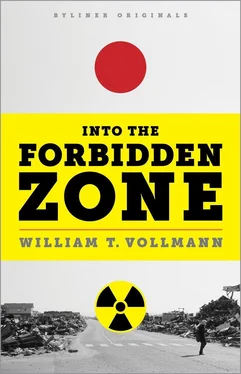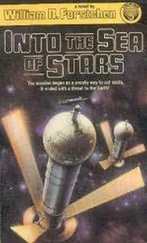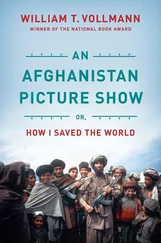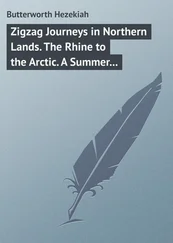“But I have a brother inside. Can I go another way?”
“You may be able to advance and go a little farther,” said the policeman.
So the motorcyclist proceeded to the unmanned checkpoint that the interpreter and I had breached. Later the taxi driver, who had spoken with him, remarked that this fellow had complained of a burning, tingling sensation, which of course is one of the first symptoms of massive radiation exposure. Perhaps it was psychosomatic, or he had some sort of allergic reaction; nobody we asked in Koriyama, even at Big Palette, had heard of anybody getting radiation sickness.
Then the driver summoned us. He had discovered an actual inhabitant: bearded and graying, with a very red workingman’s face, in a blue slicker and cap; he must have been about fifty. He wore green gloves and a mask and green boots. The metal grating of the Showa Shell service station was only half raised. He stooped just outside, hosing down a patch of pavement. He worked unceasingly while he spoke with us. He would not allow us into his house next door, in whose second-story window the drapes parted for an instant and a lovely feminine hand flickered, folding a towel over the curtain rod; this wife or daughter must have been doing laundry indoors. The drapes closed again. The workingman said, “This is the stay-at-home area. This is my area. We’ll leave soon. There’s a cat we left to stay inside, and we felt so sad not to let it out. I’m the head of the fire department here, so I come back every day, and every day I check the radiation level at the village office. Today is 0.38 millisieverts. On the seventeenth, everyone evacuated. .” 39He worked on, never stopping until I made him a present of my best respirator, at which point he paused to bow deeply, then hurried back to work.
With the cool wind still at my back and the sound of the brook louder than almost anything else, I inspected a very young bird on the grass, rust on a guardrail, manicured pines, then gazed over blank empty pavement. I went up one more driveway and rang the bell. The chimes echoed on and on; the door was locked.
For some reason, what I remember most is the bicycles leaning neatly up against the empty houses that shaded them.
Every time I looked at him, the driver eagerly started the engine. He reminded me of the forlorn boy who must stand on the snowy sidewalk just outside the hot springs near Sendai, ready to bow if any guest comes in. Finally I asked how he was. “I’m not really concerned,” he said, “but somehow I feel uneasy.”
“What makes you the most uneasy?”
“I see the cars but no people.”
Taking pity on him, I told him to commence our return, driving very slowly down the smooth pavement to the fork of highways 399 and 36, and then as the road began to rise back up into the hills, but long before we reached Mr. Sato’s home, I made the driver stop again, for I now perceived one more chance to accomplish my journalistic vulture-swoop, for here again was human life — namely, a middle-aged couple wearing those nearly useless paper masks over their mouths and striding out of their house and down the gravel driveway to their separate cars. I rushed to halt them, and the interpreter bowed with her best politeness, requesting the favor of five minutes, just five minutes, but the wife said, “We don’t have time. This is the first occasion that we have checked our home since we evacuated to Tochigi.” “How long ago was that?” Shedding all remnants of that celebrated Tohoku patience and politeness, she cried, “We don’t have time; we don’t have time!”—at which they ran into their cars without bowing goodbye, the man sweating around his mask, and drove off at nearly reckless speed, up Highway 399 toward Koriyama and then Tochigi.
The driver remarked that they seemed afraid.
Reascending Highway 399, terraces and plum blossoms, my wrists stinging strangely, no doubt simply from sunburn or that potassium iodide, we proceeded toward Koriyama; now we descended the mountainside, a brown stream glinting white in the sun, at which time the dosimeter reading increased to 2.8 millirems. I said nothing. Looking into the rearview mirror, I saw the sad bewildered fear in the driver’s eyes.
“My eyes have been pretty watery for the last two or three days,” he said. “Is it related to the radiation?”
This gentle, stolid rule-follower, who had been born in a traditional thatched-roof house and who was proud of his eighty-six-year-old mother’s health, who had prepared the receipt for me in advance and therefore firmly refused payment for the extra two hours that my loitering had required — never mind the hazardous-duty bonus I tried to give him (he did take a fraction of it) — he struck me as one of those innocents so useful to authority everywhere. I asked him whether he knew what radiation was, and he said, “I don’t know. Does it evaporate? Is it a liquid?”
“Should Tepco be punished?” I inquired.
“It was the government’s policy,” he said loyally. “They did it for the nation.”
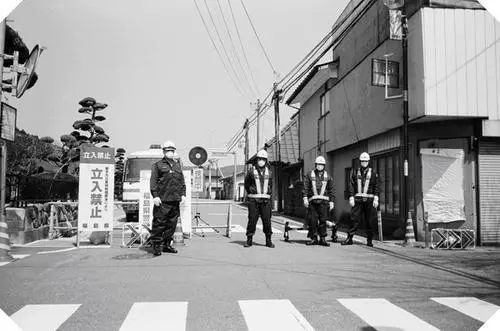
Kawauchi police guarding the entrance to the inner ring. Photo by William T. Vollmann.
ON THE DAY I ARRIVED IN HIROSHIMA, the Ministry of Energy classified the reactor accident as a Level Seven, as bad as Chernobyl. One agency said 370,000 terrabecquerels had been released so far. Another said 630,000 terrabecquerels. 40I figured that nobody knew and everybody lied.
I asked the wide-faced taxi driver who was taking me to the Hiroshima Peace Memorial Museum which he considered worse, the reactor accident or the detonation of the atom bomb over his city. He replied, “Of course, the nuclear bomb! It instantly killed more than two hundred thousand people!”
(A wall display at the museum stated that 140,000 died by the end of 1945.)
I mentioned that the Tohoku people appeared to know or care little about what happened at Hiroshima, to which he replied in his reedy voice, “Of course. More foreigners visit the museum than Japanese. At that time, I was three years old. One day before, we were ordered to evacuate because Hiroshima was a military capital and in danger.” He laughed, quite cynically and bitterly, I thought. His mother took him to the countryside, but on the day after Little Boy was dropped she returned to Hiroshima to look after relatives, which was why she — lucky woman! — became eligible for atomic victim status. “She showed no symptoms, but when I was fourteen she got recognition. Myself, if you have that hibakusha health book, if you’re a victim, that means that no one wants to marry you, so I didn’t want to get one.”
He went on: “Those who used to live close to the dome”—the hypocenter of the explosion—“they hide it, since they are discriminated against.”
“How many years did it take for the radioactivity to go away?”
“For that I’m not sure, but in 1945 they said that for fifty years no plants would grow, and soon weeds came.”
“Do you think that the reactor accident at Fukushima could affect people here?”
“I think it’s rather irrelevant to me. I won’t be affected. You’re going to the museum, and you’ll see that the atomic bomb gives you burns and hair loss,” he explained wisely, and so we pulled up there, on the edge of the Hongkawa River, among the pinkish-white clouds of cherry blossoms.
Visiting the museum, my heart grew as brown-gray as a salinized rice field. The torn, stained rags of the summer uniform and chemise that the thirteen-year-old schoolgirl Oshita Nobuko had sewn herself, oh, yes, these flattened, faded, bloody tokens, weren’t those enough to see? Just as one can find on display at that museum a lightbulb painted black except for a neat ring of transparency at the base, in order to decrease, however slightly, the probability that the Allied bombers could locate nighttime targets, so I could see of various radioactive issues, matters, and agendas what little there was to see. And I have told you what I saw. What did I see? What did I know?
Читать дальше
